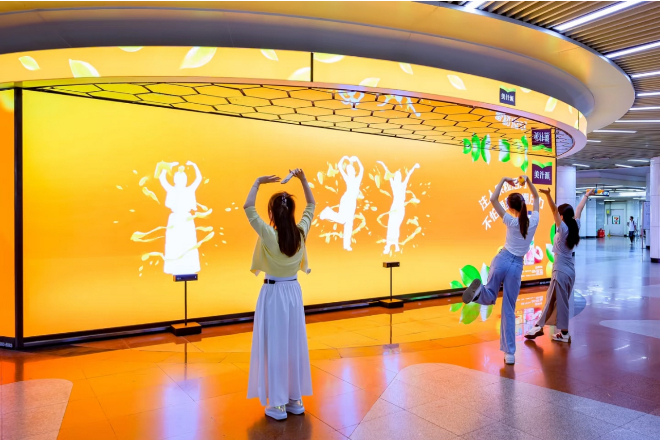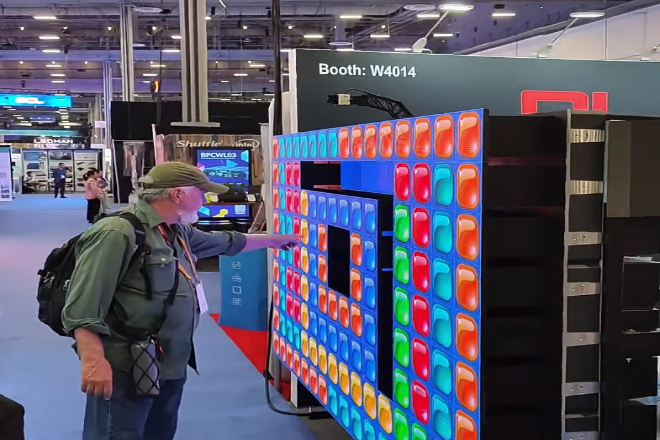Introduction

Where have you seen interactive LED displays? As a special type of LED display, interactive Afficheurs LED are gradually being used in public places. This article will talk to you in detail about how interactive LED displays optimize the public service experience. Let’s read the article together.
1. Overview of interactive LED display technology
In simple terms, interactive LED displays are displays that you can not only watch, but also “play” with. Unlike traditional LED screens that can only display information in one direction, it adds various interactive elements that allow you to touch, talk, and even control it with gestures.
This display is composed of a large number of small LED beads, each of which can emit light independently, so the picture is particularly clear and bright.
In fact, the working principle of interactive LED displays is quite interesting. It first uses those LED beads to spell out pictures of various colors and shapes and then has some super-sensitive sensors built in, such as touch screens, infrared sensors, microphones, etc.
When you touch it, talk to it, or make gestures, these sensors can capture your movements or sounds and convert them into digital signals.
Then, the “brain” in the display screen – the control system, will process these signals and respond accordingly, such as switching screens, playing sounds, or executing a certain command.
1). Unique technical features
1.1). Interactive function:
- Touch function:
Just like playing with a mobile phone, you can directly tap on the interactive LED display screen with your hands to select the content you want to see or play some small games.
- Voice recognition:
Some advanced interactive LED displays can also “understand” your words. You only need to speak softly, and it can help you find the information you want to see or execute a certain command.
- Gesture control:
What’s even more amazing is that some displays can also recognize your gestures. You wave your hand, it can switch the screen; you make a specific gesture, it can perform a specific function.
1.2). Remote control and real-time content update capabilities:
- Télécommande:
The interactive LED display screen can also be remotely controlled. No matter where you are, as long as there is a network, you can check the status of the display screen at any time, adjust the content played, and even troubleshoot.
- Real-time content update:
In this era, information is updated too fast. Interactive LED display screens can receive and display the latest content in real-time, allowing you to see the latest and most accurate information at any time.
2. What are the places suitable for using interactive LED display screens?
1). Musées
1.1). Improve the exhibition effect:
The interactive LED display screen is really bright, with super high clarity and rich colors, making the museum’s exhibition look super cool! It can simulate historical scenes, making the audience feel like traveling back in time and experiencing historical events firsthand.
Moreover, it also supports ultra-high-definition resolutions such as 4K and 8K, and the details of the cultural relics can be seen clearly, whether it is the small patterns on the pottery jars or the brush and ink in calligraphy and painting, which can feast the eyes of the audience.
This immersive exhibition makes the audience more interested and more willing to participate.
1.2). Enhance interactivity:
Another cool feature of the interactive LED display screen is that it can be touched! The audience can move their fingers to understand the history of the cultural relics, how they were made, and their cultural significance.
For example, when displaying ancient weapons, the audience can touch the screen to see animations of how the weapons are used and even play simulated battle games to personally feel the power of the weapons.
This kind of interaction makes the exhibition more interesting, and the audience can remember the cultural relics more deeply.
1.3). Innovative display form:
Interactive LED display screens are particularly flexible, making the exhibition form of the museum more diverse. The science and technology exhibition hall can simulate natural scenes such as the starry sky and the deep sea, making the audience feel like they are in the universe or the ocean.
For the cultural and art exhibition halls, the LED display screen can become a historical scroll, slowly unfolding a thousand-year story, allowing the audience to appreciate the art while also feeling the weight of history.
This innovative display makes the museum’s exhibition content richer and improves the audience experience.
2). Aéroport
2.1). Information guidance:
Interactive LED display screens are really useful in airports! It can update flight information, boarding time, and flight status in real-time, allowing passengers to keep abreast of flight dynamics at any time and arrange their itinerary reasonably.
In addition, it can also display guidance information for security checks, boarding, and arrival, reducing confusion and delays caused by information asymmetry.
2.2). Intelligent interaction:
The airport’s interactive LED display screen also has a touch function. Passengers can check flight status, view navigation maps, and obtain other service information by touching the screen. In this way, passengers’ self-service capabilities are improved and the workload of airport staff is reduced.
In addition, the display screen can interact with passengers’ mobile phones to provide personalized services, such as pushing luggage collection notifications and boarding gate change reminders.
2.3). Commercial promotion:
The airport has a large number of people and great commercial value. The interactive LED display screen can play commercial advertisements of the airport and its surroundings, provide passengers with shopping and dining options, and promote the development of airport business.
Enterprises can also use the display screen to promote brands, promote products and services, and expand the commercial market.
3). Ville intelligente construction
3.1). Information dissemination:
The interactive LED display screen is like an information dissemination platform for smart cities. It can publish government information such as policies, regulations, and announcements in real time, improve government transparency, and make citizens trust the government more.
In addition, it can also provide public service information, such as weather, transportation, culture, and tourism, to help citizens arrange their lives and travel reasonably.
3.2). City management:
Interactive LED display screens are also very important in city management. Through the display screen, traffic management information such as road conditions and traffic control measures can be displayed in real-time to guide citizens to travel rationally and relieve traffic pressure.
Moreover, it can quickly release public safety information, such as emergency notices and warning information, to improve citizens’ safety awareness and effectively respond to emergencies.
In addition, the display screen can also update environmental data such as air quality, temperature, and humidity in real-time to provide citizens with a reference for healthy living.
3.3). Interaction and intelligence:
Interactive LED display screens have touch functions and intelligent management systems, allowing citizens to interact with the city in real-time. Citizens can give feedback and suggestions by touching the screen and participating in city governance.
Moreover, the display screen can automatically adjust the brightness and content according to factors such as environment and time, reduce energy consumption, and improve efficiency.
This interactive and intelligent management method not only improves the management level of the city but also enhances the sense of participation and belonging of citizens.
3.4). City image display:
Interactive LED display screens are like the “window” of the city, which can show the unique charm, historical culture and modern style of the city. By playing city promotional videos and cultural programs, the city’s popularity and reputation can be improved, attracting more tourists and investors.
Moreover, the display screen can also serve as an important platform for urban cultural activities and commercial promotion, providing citizens with a rich and colorful audio-visual experience.
3. Advantages of interactive LED display screens in public services
With interactive LED display screens, this high-tech gadget shines in public services and brings a lot of convenience and fun to people’s lives.
Speaking of it, it has many advantages, mainly reflected in improving the efficiency of information transmission, enhancing user interactivity, and improving the service experience.
1). Improve information transmission efficiency
Interactive LED display screens are like information express boys, updating in real-time and conveying in seconds. Important notices, announcements, and guidelines will be displayed immediately as soon as they are updated so that you will no longer miss any important information.
The situation where information was delayed, and it took a long time to know is rare now. In addition, it can also dynamically display service processes and queuing situations, like a transparent window, so that you can see the service process at a glance.
In this way, you will have a bottom line in your heart, and you don’t have to guess blindly.
2). Enhance user interactivity
When it comes to interactivity, interactive LED displays are experts. Touch and voice recognition allows you to play with it and talk directly to the service. If you want to check something or do something, just move your fingers and talk, and you’ll get it done.
Moreover, it understands you very well and can provide personalized service options based on our preferences. If you want to read some news, listen to some music, or play some small games, it can satisfy us. This sense of interaction makes the service more intimate and more interesting.
3). Improve service experience
Service experience is the specialty of interactive LED displays. Its visual and auditory effects are simply an immersive little world. Looking at the picture, it is as clear as the real thing; listening to the sound, it is three-dimensional and makes people feel like they are there.
In this environment, whether it is watching promotional videos, participating in interactive games, or listening to voice guides, it feels very good. Especially in places with long waiting times and interactive LED displays, we are no longer bored.
Playing small games and learning new knowledge, time flies by, and the service experience is greatly improved.
In general, the interactive LED display is an all-round assistant in public services. It makes information transmission faster, makes services more interactive, and makes the experience better.
In the future, as technology becomes more and more advanced and more and more application scenarios are applied, the interactive LED display will definitely bring more surprises and convenience to our lives!
4. Challenges and countermeasures of interactive LED display to optimize public service experience

The application of interactive LED displays in the field of public services has undoubtedly brought a lot of convenience and fun to our lives.
However, like any emerging technology, it also faces some challenges in the process of development. Next, let’s talk about these challenges in detail and how to deal with them.
1). Défis techniques
1.1). Touch accuracy issues in high-luminosité environments
In direct sunlight outdoors or strong light indoors, the touch function of the interactive LED display may be disturbed, resulting in inaccurate touch or even no touch.
This is undoubtedly a huge obstacle for operations that require precise touch.
1.1.1). Countermeasures and suggestions:
- Technology research and development:
Increase R&D investment in touch technology, and develop touch technology that is more suitable for high-brightness environments, such as infrared touch, ultrasonic touch, etc.
- Screen design:
Special design of interactive LED display screens, such as adding anti-glare coatings, improving screen brightness contrast, etc., to improve visibility and touch accuracy in high-brightness environments.
- Algorithm optimization:
Optimize the touch algorithm, improve the anti-interference ability of the touch system, and ensure accurate touch in high-brightness environments.
1.2) Accuracy of speech recognition and natural language processing
Speech recognition technology may be affected by environmental noise, dialects, accents, and other factors, resulting in low recognition accuracy.
Natural language processing technology may not accurately understand the user’s intentions, resulting in inaccurate service responses or not meeting user expectations.
1.2.1). Countermeasures and suggestions:
- Technology upgrade:
Introduce more advanced speech recognition technologies, such as deep learning, neural networks, etc., to improve recognition accuracy and robustness.
- Dialect support:
Strengthen the recognition ability of dialects and accents, and adapt to dialects and accents in different regions by training models.
- Semantic understanding:
Improve the semantic understanding ability of natural language processing technology to ensure that the user’s intentions and needs can be accurately understood and appropriate service responses can be provided.
2). Content management challenges
2.1). Ensure the accuracy and timeliness of displayed content
The content displayed on the interactive LED display needs to be accurate and updated in a timely manner to reflect the latest information.
If the content is wrong or outdated, it may mislead users or cause inconvenience.
2.1.1). From countermeasures and suggestions:
- Content management system:
Establish a complete content management system, clarify the content update process and division of responsibilities, and ensure the accuracy and timeliness of information.
- Automatic update:
An automated content update system is used to achieve real-time updates and display information through interface docking or data synchronization.
- Audit mechanism:
Establish a content audit mechanism to strictly control the published content to ensure the accuracy and compliance of the information.
2.2). Balance the display ratio of advertising and service information
Interactive LED displays need to display service information and may need to play advertisements to obtain revenue.
How to balance the display ratio between the two to meet service needs and realize commercial value is a problem that needs to be solved.
2.2.1). Countermeasures and suggestions:
- Display rules:
Formulate reasonable display rules and clarify the display ratio and time period of service information and advertisements.
- Content screening:
Strictly screen and review the advertising content to ensure that it is consistent with the atmosphere and image of the service place and avoid excessive commercialization or vulgar content.
- User feedback:
Establish a user feedback mechanism to collect users’ opinions and suggestions on advertisements and service information and adjust the display ratio and content according to feedback.
Conclusion
In summary, the interactive LED display screen plays an increasingly important role in the field of public services with its unique display characteristics and interactive functions.
It not only improves the efficiency of information transmission, makes services more transparent and convenient, but also enhances users’ sense of participation and experience, making public services more humane and intelligent.
Enfin, si vous souhaitez en savoir plus sur les écrans d'affichage LED, veuillez nous contacter.
